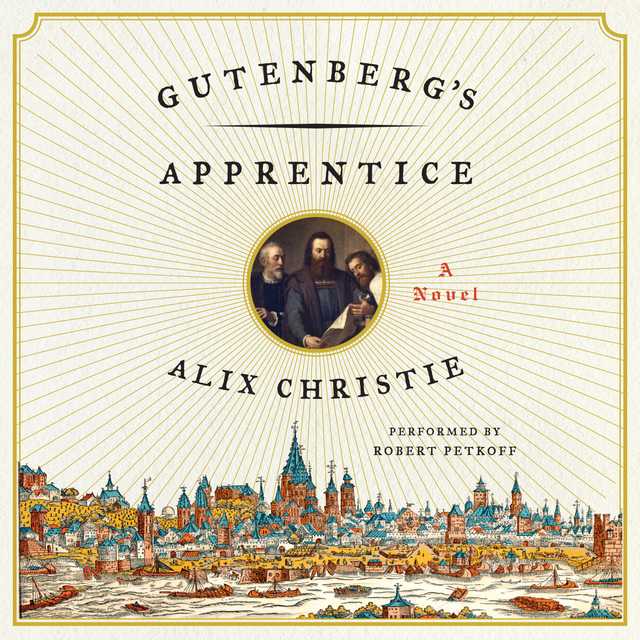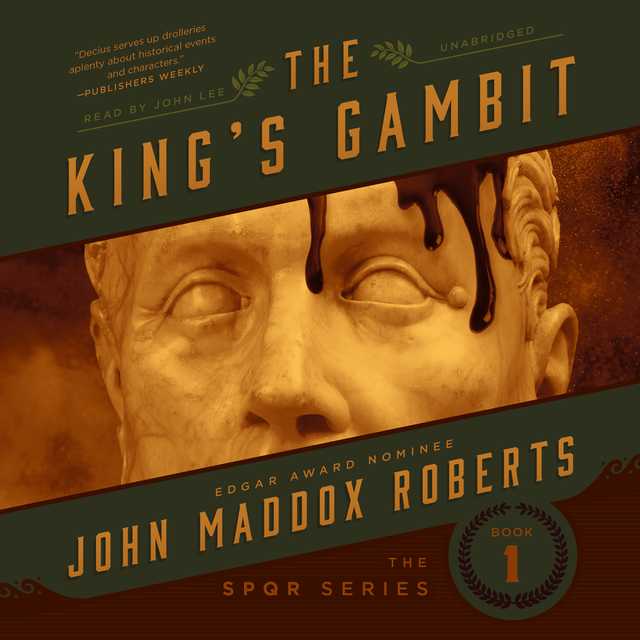Gutenberg’s Apprentice Audiobook Summary
“A finely atmospheric debut…Christie’s novel is a worthy tribute to the technological revolution it reimagines, as well as a haunting elegy to the culture of print…One thinks of Donna Tartt’s obsessive accounts of furniture decoration in The Goldfinch or even Philip Roth’s lovingly twisted empathy with glovemaker Swede Levov in American Pastoral. Such novels of craft and specialization take a writerly delight in the most intricate details of a particular trade while spinning rich prose out of its mysterious threads.” — Washington Post
An enthralling literary novel that evokes one of the most momentous events in history, the birth of printing in medieval Germany–a story of invention, intrigue, and betrayal, rich in atmosphere and historical detail, told through the lives of the three men who made it possible.
Youthful, ambitious Peter Schoeffer is on the verge of professional success as a scribe in Paris when his foster father, wealthy merchant and bookseller Johann Fust, summons him home to corrupt, feud-plagued Mainz to meet “a most amazing man.”
Johann Gutenberg, a driven and caustic inventor, has devised a revolutionary–and to some, blasphemous–method of bookmaking: a machine he calls a printing press. Fust is financing Gutenberg’s workshop and he orders Peter, his adopted son, to become Gutenberg’s apprentice. Resentful at having to abandon a prestigious career as a scribe, Peter begins his education in the “darkest art.”
As his skill grows, so, too, does his admiration for Gutenberg and his dedication to their daring venture: copies of the Holy Bible. But mechanical difficulties and the crushing power of the Catholic Church threaten their work. As outside forces align against them, Peter finds himself torn between two father figures: the generous Fust, who saved him from poverty after his mother died; and the brilliant, mercurial Gutenberg, who inspires Peter to achieve his own mastery.
Caught between the genius and the merchant, the old ways and the new, Peter and the men he admires must work together to prevail against overwhelming obstacles–a battle that will change history . . . and irrevocably transform them.
Other Top Audiobooks
Gutenberg’s Apprentice Audiobook Narrator
Robert Petkoff is the narrator of Gutenberg’s Apprentice audiobook that was written by Alix Christie
About the Author(s) of Gutenberg’s Apprentice
Alix Christie is the author of Gutenberg’s Apprentice
More From the Same
- Publisher : HarperAudio
- Abraham
- American Gods [TV Tie-In]
- Dead Ringer
- House of Sand and Fog
- Prey
Gutenberg’s Apprentice Full Details
| Narrator | Robert Petkoff |
| Length | 14 hours 9 minutes |
| Author | Alix Christie |
| Category | |
| Publisher | HarperAudio |
| Release date | September 23, 2014 |
| ISBN | 9780062362124 |
Additional info
The publisher of the Gutenberg’s Apprentice is HarperAudio. The imprint is HarperAudio. It is supplied by HarperAudio. The ISBN-13 is 9780062362124.
Global Availability
This book is only available in the United States.
Goodreads Reviews
Will
September 18, 2019
In principio erat verbumIn the beginning was the word, (well according to John 1:1 anyway) but in the absence of someone writing it down, then printing millions of copies, you might never have known. So maybe in the beginning was the word but right behind it was the printer. Before Stephen King, Dan Brown, JK Rowling or AC Doyle, there was once a major global best-seller, the first one. It had an initial printing of one hundred eighty, and it changed the world. The finished product - from the University of Texas Harry Ransom Center LibraryAlix Christie has given us a look at how the Gutenberg bible came to be, and in so doing has illuminated the image we might have of this seminal work with portraits of the man himself, the era in which he lived, the politics of the time, details of the technical advances that went into development of the movable type press, and a look at the people involved. When you combine the words Gutenberg with Bible, you might conjure an image of some monkish guy in a garage basement, or barn, banging away at his personal project until Voila! You might also think printing the bible was his first gig. Turns out, not so much. While it may not have taken a village to make the famous big book, it came close. Johannes Gensfleisch, the man we know as Gutenberg, (the name of the town where his mother had been born) had some help. There is no question that he was a genius, and that his notions of using movable metal type ushered in a new age. But he was also a very results oriented entrepreneur. Bit of a slave-driver too, as well as being someone of questionable ethical standards, and maybe not the guy you would want having your back in a critical moment. One of the joys of Alix Christie’s tale is learning at least some of the many challenges of all sorts that had to be met along the way from revolutionary printing notion to reality. She came on her less-than-glowing notions about Gutenberg as the sole source of the genius behind the press as a result of relatively recent research by several European scholars. She goes into details on the book’s site.The author - from her Facebook pageOur window into this world is his assistant. Peter Schoeffer, the apprentice of the title, was a scribe in Paris when Johann Fust, who had adopted him, summoned him back to Mainz (pronounced mīn(t)s) to work as Genfleisch’s apprentice. Fust had seen what Gutenberg might do with his marvelous new machine and committed a significant financial stake to the project. Part of the deal was for Peter to be an apprentice in Gutenberg’s shop. Fust’s intentions were not wholly beneficent. He wanted a spy on the inside. The story of how the bible was ultimately made is given by Peter, relating his history to a monk many years later. We step back and forth between the then (1450-1454) and the now (1485), of the story. This offers the author a way to present some views on Gutenberg from a more objective distance. Well, from a distance, anyway. JG is presented in a rather dim light as seen through Peter’s eyes. Johannes Fust and Peter SchoefferIn the world of the late 15th century the Catholic Church was a particularly corrupt and oppressive force, impacting the world of earthly politics to an unholy degree. It was within the power of an archbishop, for example, to essentially quarantine an entire city if, say, the ruling council of that city went against his wishes. The Church was also busy selling indulgences, pieces of paper on which the church had incorporated its imprimatur, and which, once you filled in your name, would guarantee forgiveness in heaven for sins committed on earth. The 15th century variety was a way for the church to raise funds, for things like Crusades and large papal celebrations. As the mass production of these monstrosities could be stunningly lucrative to the church, those in charge had a considerable interest in the possibility of new printing technology. And Gutenberg had to be on his guard to keep the church from learning of his project too soon, lest they seize his entire workshop for their own purposes. Secrecy was paramount, and many tongues needed to be stilled for the project to proceed. This creates considerable tension in the story, even though we know that the book is eventually made. Christie also looks at the local politics of the city, the importance of guilds, and the political push-pull of the elders (think the one percent) vs the workers (in this case, guilds). The G-ManThe focus on the people involved in the time and place make this a tale of Mainz and men (sorry), and not just a tracking of technological innovation. There is a bit of romance in here as well, as Peter and a local lass become entangled. This offers Christie an opportunity to look at the status of women in the late 15th century and note the life-threatening aspect of childbirth that was much more a hazard then than it is today. Of course the tech stuff is fascinating, as it took considerable trial and error to work out the kinks. Christie is a master of these details. As she should be. She apprenticed as a printer and owns a working press. However, she is equally adept at portraying the many interpersonal tensions and complications in the relationships of the major players. For centuries the ruling class had run the city like their private bank. They’d lent the council sums they then repaid themselves at crushing rates of interest. These bonds they then bequeathed to their own spawn, in perpetuity. Thus was the city fated to insolvency, like half of the free cities of the Reich. Each time the treasury was bare, Archbishop Dietrich would step in, prop up that rotting edifice, enact some other tax that only workingmen and merchants had to bear. Contemporary issues resonate here. Just as the internet, a marvelous bit of technology, can be put to low or dark purposes, so could the original printing press. In fact an early money-maker for Gutenberg was the equivalent of a penny-dreadful. The selling of indulgences by the Church is echoed today whenever the Department of Justice investigates corporations for malfeasance. What remains clear is that tools, even miraculous ones, are only as good as the people who control them. The stresses between old and new, between powerful and less powerful, between religious and secular power comes through. BTW, one of the reasons Gutenberg opted to produce a bible is that a project that was in the works with church leaders to print a standardized missal fell through. I suppose one might call this an early missal crisis. I wouldn’t, but I suppose some might. The pressI expect Christie was hewing as closely as possible to the history she is writing about. Peter was a real person, as were all the major and maybe even minor characters in this impressive book. As the fictional Peter here tells his story to a monk many years after the events described, so the real Peter did the same. This is definitely an instance in which the historical aspect of this historical novel is a very powerful element. She even includes in an afterword a bit of what happened to each of the characters after the bible was completed. No, nothing on Dean Wormer. I have two gripes with the book, neither of them major. I appreciate Christie hewing to history in her re-telling of how the great book came to be, but I did not find the steps forward to Peter’s telling the tale to a monk altogether necessary. Second, one thing you should know about Gutenberg’s Apprentice is that, as informative and satisfying as it is, it is a slow read. At least it was for me. You are unlikely to be taking this one to the beach to while away a few hours. But if you settle in for a longer spell, you will be richly rewarded. Gutenberg’s Apprentice may not be the first book you have ever read, but it will definitely leave a lasting impression. Trade Paperback - 9/8/15This review is cross-posted on my blog, CootsReviews and on Fantasy Book Critic=============================EXTRA STUFFAn informative Wiki piece on Fust and Schoeffer A nice video on the press. Ignore the word kids on the site. This is accessible and interesting, even if the documentary video cadged music from John Adams and is a bit amateurish.A nifty wiki article on movable type==================================AUTHORLinks to the author’s personal, Twitter, Google+ and FB pages In addition, there is a lot of excellent material on Christie’s book site
Mieneke
October 13, 2014
The invention of the printing press with movable type was arguably one of the biggest impulses that brought about the advent of the Renaissance and one of the biggest change agents in civilisation.The ability to print texts in large quantities quickly and at a markedly reduced cost changed medieval society in much the same way as the advent of the internet did ours. As an English Lit major specialising in book history, Gutenberg is naturally a person of interest to me, so when I saw Alix Christie’s Gutenberg’s Apprentice on the Headline site I knew I had to read it. Within its covers I found a riveting tale of a man driven by vision and ambition and the apprentice who was pressed into his service against his desire.Gutenberg’s Apprentice works on several levels. The most obvious one is Peter’s story, his involuntary apprenticing to Gutenberg, his slow growing appreciation of the printing arts, and his finding a place for himself in this changing world. The second level is the story of the transmutative nature of the age. The middle of the fifteenth century was a tempestuous era in which politics and religion were all in a state of flux and the world seemed on the constant precipice of war. Through Gutenberg and Peter’s story we witness how unsettling these times were for the people living through them. Lastly, the narrative functions as a mirror on our recent history. The book is very much a reflection of our society’s reaction to the advent of the internet. There is fear, horror, and disgust, but also great enthusiasm for this new art, utter devotion to the idea and an acknowledgement of its limitless possibilities.The characters of Peter Schoeffer and Johannes Gutenberg are at the heart of the story, which is told from Peter’s point of view. Christie manages to convey his anger, frustration, and confusion with his new status and master very well and makes it easy to let the reader identify with him. Peter was trained to be a scribe and his love for his craft and his pride in the manuscripts he produces shines through. As a scribe he’s also in a unique situation to understand the meaning of Gutenberg’s invention, though even Peter doesn’t foresee its eventual consequences to society. Peter is a sympathetic character: a dutiful son to his adoptive father, a hard worker, but also ambitious and not always as good a friend and suitor as he should be. I loved the stormy relationship between Peter and Gutenberg, which goes from reluctant to true respect and even a strange kind of affection to ultimately anger and resentment.Gutenberg is a bit of a Steve Jobs avant le lèttre – a visionary, ambitious, ruthless, and driven to complete his vision to perfection. His is clearly a brilliant mind, but a troubled one and one that doesn’t play well with others. The way he set up his workshop, essentially closeting his workers away for the duration, so as to not let the secret of his invention spill out was somewhat maniacal and disturbing. Yet at the same time, despite his mercurial moods and foul temper, the workshop where Peter labours with about a dozen others is a harmonious and fascinating place and the scenes where we just witness the men at work on creating their bibles were some of my favourite in the book.Like today, business espionage was rife and in the days before the invention of patents, anyone could steal your design, which explains Gutenberg’s obsession with secrecy. Yet, his secrecy was also due to political machinations. Gutenberg was an odd duck, a patrician working as a tradesman, yet not part of any Guild, something that creates no end of tension between him and the Guilds in the novel, both due to the Guilds’ innate trust of those from the social strata above them and the fact that they couldn’t control – and profit – from his trade. Additionally, there are the politics of the Church and the Holy Roman Empire, which were largely clerical, but manifested in secular affairs as well. Gutenberg has his spoon in all of these boiling pots, stirring them this way and that to gain as much advantage as he can and not always with a positive result. It creates added tension in the story and lends urgency to the narrative as Gutenberg, Peter, and the crew strife to finish their work before it is discovered.Gutenberg’s Apprentice is sneakily compelling. Christie’s prose is evocative and atmospheric, drawing the reader into Gutenberg’s workshop and the streets of Mainz. While this review has focused mostly on Peter and Gutenberg, there are several more wonderful characters, such as Peter’s adoptive father, Johann Fust, and Peter’s sweetheart, Anna to name but two. Gutenberg’s Apprentice shows a world on the cusp of a major technological revolution and if the book is a must-read for anyone interested in the history of the book, is it just as much a compelling read for those who are interested in societal change and the forms it takes. I loved Gutenberg’s Apprentice and I highly recommend it. Alix Christie is certainly an author whose work I’ll be keeping an eye on in the future.This book was provided for review by the publisher.
Bruce
January 15, 2015
[Review originally published in The Washington Post, 12/12/14]“Before there was Zuckerberg there was Gutenberg!” screams the clever promotional material for Alix Christie’s finely atmospheric debut. As the world of hard copy crumbles beneath our feet, it can be easy to forget that print culture has been with us for only a few centuries. If Gutenberg’s Apprentice isn’t quite to the printing press what The Social Network is to Facebook, perhaps that’s a good thing. Only a historical novel is capable of reconstructing this earlier transformation in social media with the full complexity it deserves.Johannes Gutenberg is often imagined as a lone Renaissance genius who singlehandedly invented the technology of moveable type. Gutenberg’s Apprentice tells a messier, more satisfying story. Here the printing press emerges from within a grinding milieu of smoke, metals, and labor that shaped a medieval revolution of the word with great relevance to our own moment. Christie, a journalist and critic currently living in London, is a devotee of letterpress printing, and she supplements her hands-on experience with a thorough grounding in the most recent scholarship on the early history of the medium. Yet Gutenberg’s Apprentice wears its erudition lightly and elegantly, as in a description of “regal dyes—the purple of the popes and kings, crushed out of Adriatic snails” (227), or of the making of carmine ink: “oil of linseed boiled to varnish, mixed with powdered copper, cinnabar, some carbonate of lead” (179). Such details are the grist of historical fiction, of course, and in Christie’s hands they feed a paper mill that extends even to the design of the book’s pages, which feature lined borders and elaborately drawn initials, as if to model the flourishes in an early printed book. (You won’t get this on your Kindle, folks!)The novel’s story begins at the end, following the deaths of “both Johanns” (2): Gutenberg himself as well as Johann Fust, Gutenberg’s partner and financier as well as the foster father of Peter Schoeffer, our protagonist. A local boy made good, Peter is a highly-trained scrivener, an anti-Bartleby of sorts, eager to continue his careerist climb through the scribal ranks of Paris, where the rector of the university has recently tapped him for advancement. Instead, as the story begins, Peter is summoned home to his native Mainz, now a dreary, repressive city emptied of its wealthy class in the wake of an uprising years before. Unwillingly apprenticed to Gutenberg, Peter is torn between the loving labor of script and the mechanical allure of print. At first he regards the printed page as “a crude and ugly copy of the best that man can do” (50). The story of his transformation is closely tied to the success of Gutenberg’s enterprise, as well as his own adeptness at negotiating the politics of city, guild and church to surpass his master and emerge as the most successful printer of his generation. Gutenberg himself remains something of an enigma here, despite Christie’s noble efforts to put flesh on this elusive historical figure. A tyrant in his workshop, the master exhorts, cajoles, and threatens his laborers until he gets the precise result he wants, even while leaving room for their own ingenuities and skills to develop within the closely-guarded confines of the Mainz workshop, a very male world indeed. “We all slopped out of Eve,” Gutenberg wryly observes. “You know the good that brought” (139). Christie’s tensely claustrophobic narrative relates the tragedy of a fruitful and promising collaboration threatened by the self-interest and vanity of its partners.The real hero of Gutenberg’s Apprentice is the press itself, this horrifying, beautiful machine capable of throwing out “a boundless net of shining letters” (173). Near the middle of Christie’s novel, Gutenberg and Fust hit on the momentous idea to print the Latin Bible in its entirety. As Peter prepares the initial type, he summons those “words that brought a new world into being,” the opening verse of Genesis: “Peter set them flush against a nothingness; hard against a nonexistent margin he arranged them, floating like the world itself in a great void” (125). It’s a beautiful image, rendering the printing press as a medium of ethereal transcendence that depends nevertheless on those gnarly chunks of metal poured and etched in the workshop over months and years of sweaty toil. One thinks of Donna Tartt’s obsessive accounts of furniture restoration at the heart of Theo Decker’s story in The Goldfinch, or even Philip Roth’s lovingly twisted empathy with glovemaker Swede Levov in American Pastoral. Such novels of craft and specialization take a writerly delight in the most intricate details of a particular trade while spinning rich prose out of its mysterious threads. Christie’s novel is a worthy tribute to the technological revolution it reimagines, as well as a haunting elegy of sorts to the culture of print.
Denice
August 26, 2014
Have you ever read a book? Have you ever thought about how that was possible? Who made it possible? I think we all know who Gutenberg is. Like we all know who Christopher Columbus is. We can do it in one sentence. “He invented moveable type and printed the Bible.” Done deal. But like we don’t really know off the top of our heads what Columbus himself was like, or what his coming to this hemisphere truly meant. One sentence about Johann Gensfleisch, Gutenberg, isn’t going to do it either. If I told you all about this book I’d be blathering and really, I couldn’t tell you enough. Let it be said, it was the most informative novel I’d read in years and couldn’t put it down till late at night nor could I wait to get back to it.At the time, what Gutenberg did had to be done in absolute secrecy if he was going to trump the Church and the world. This secret that had to be kept for over five years because that’s how long it took to find a metal alloy that would hold up to repeated pressings without losing shape and find a way to cast those letters fast and efficiently.Build the page and print. No one had ever done this casting of small letters before. Ever. Each letter had to be set minutely at the same depth or the pressing would be uneven. The ink would run loose in the summer and hard in the winter. It took a lot of sheep (velum) and ink and lead and varnish and money and dedication while the way was being invented as these workers who dedicated themselves to the project went along. Mistakes were made, new processes had to be worked out. Gutenberg is given the credit for the Bible but he had a crew of four men who actually did the work. Gutenberg walked off the project half way through. There goes our romantic image of a single man lowering a press and imprinting a page. He was volatile, rude, pompous and self-centered and if it weren’t for the four men he chose this Bible would never have been printed. At least not by him. To do what Gutenberg envisioned was considered blasphemous, the work of the devil because the work of a scribe is God given. No one on earth had seen anything like this. First among his crew was Peter Schoeffer, a scribe whose skill with the pen was known to many. He was taken from the monastery where he worked at copying scripts to work for Gutenberg. While Peter was at first bitter to be forced to give up his work eventually he was essential to the work on the Bible. Feuds between Gutenberg and their investor, the guilds trying to find out what was going on in that workplace, plague, Crusades, the pompousness of the Church, the struggle to find a text to print. None of the process was easy. None of it ever done before.In the end, Schoeffer said, “Gutenberg’s genius lay in ordering the work, in breaking down and rearranging all the pieces.” Actually, they printed 180 copies. And the world would never be the same. Between 1450 and 1500, fifty short years, more than 250 printers set up shop.If you are a reader, if you’ve ever held a book in your hands we have Gutenberg and his vision and the dedication of his workers to thank for it. What he did was move the world forward in one giant leap. I would like to quote a passage, “His type was artificial, yes, but even so the words it made were still the same. Vain, to stand against it: printing would roll out and inundate the world.” A printed book with letters made artificially was still a book. And the irony was not lost on me that I read an advance copy of this book on my Kindle.
João
July 21, 2019
Depois de terminado este livro tenho pena que não seja possível classificar com "meias estrelas", porque gostava de dar quatro estrelas e meia, já que considero que este livro quase chega às cinco estrelas!Uma história bem planeada e toda baseada em factos e personalidades que sabemos terem existido!Muito bem moldado este conto, realmente!Um pensamento que me acompanhou ao longo de todo o livro: estar a ler sobre a primeira impressão feita e pensar que se não tivesse sido essa coragem e ao mesmo tempo esse espírito inventivo hoje em dia seria tão mais difícil ter a livros da forma como temos hoje! Seria um mundo bem mais triste e vazio se não tivesse sido criada essa invenção a que hoje quase não ligamos: a impressão em série!Um bom livro!
Molly
April 23, 2017
Wonderful read. Lovely moments and images. Especially compelling are the connections drawn between text and creation, between the word and the divine, between the Word and humanity...the greater implications of the miracle of moveable type are explored by looking at the lives of those intimately involved. It's a lovely read, set in it's own purposeful way. I enjoyed it. Shakespeare lingers about the edges - his language foreshadowing one of the greatest uses of Gutenberg's vision. Not a bad book to finish on Shakey's probably-birthday :)
Wendy
July 03, 2020
One of my first jobs in the 1970's was as a typesetter for the Federal Government. While I can't remember how, I do remember making calculations to right justify our type lines! I remember the days before "white out" and "memory". Our modern Word Processors are the distant relatives of the very first printing press!! We forget that one day, someone actually had to invent that equipment! To read the accounts of those early, magical days was exciting, and that the first book they decided to print was the Holy Bible, the Book of Books, is glorious! Not only do I now have a greater appreciation for the printed word, but I also have a greater appreciation for the Bibles I own. Yes! Multiple copies! Once upon a time, the only existing copies were hand written by Scribes. Sadly, that art is practically extinct, but today everyone can own their own printed books, and that is marvelous!
Bibliovoracious
October 21, 2019
I loved this. Deeply researched, enriched with personable and gritty characters, this book truly builds a vision of what an extraordinary and unlikely achievement Gutenberg's Bible was. By all the odds, it should have been impossible in the world at the time. Superstitions and paradigms, religious power-mongering, not to mention the burden of secrecy and the spectacular financial investment that it took - in the face of the existing challenges, the feat is truly amazing. The audiobook is excellent.
Amber
September 20, 2014
When I first saw the title I wondered how the story could be made interesting, since we all know how it ends—a printed Bible—but the process was full of personal, social, religious and political controversy. Who was to be allowed to control books? The power of the medieval Catholic Church in money and politics was pervasive. The German city of Mainz, where Gutenberg started his printing press, was at odds with its archbishop overlord. One of the many things the church controlled at the time was access to books. The invention of moveable type posed a threat to those in power, and to those for whom writing by hand was a sacred, contemplative art. Peter Schoeffer was one of the latter, before he became Gutenberg’s apprentice.Prior to reading this book, I’d never heard of Schoeffer. Author Alix Christie found, among other records, extensive interviews with him written by a monk, Trimethius. Schoeffer, it turns out, was as important as his master. Christie makes every step of the process of printing that first Bible come alive with Schoeffer’s passions. His relationships with his foster father who was Gutenberg's business partner, with Gutenberg himself—an eccentric and difficult character—and with his fellow workers in the printing shop are based on meticulously researched historical fact, enlivened by the author's interpretation. Peter’s courtship of the young painter Anna Pinzler is told beautifully, with one of the most mystical and uplifting love scenes I’ve ever read. If you like to explore a book that immerses you in the mind, heart, life and work of a man of another time and place, this one will absorb you completely. It’s not a book to rush through, any more than Schoeffer could have rushed through his carving of a perfect letter.Each chapter starts with a large, ornate capital that looks hand-lettered, imaginative and full of flourishes, the lines ever so subtly imperfect. Having studied calligraphy and hand engraving, I appreciated this touch, and the reminder that books as works of art, as physical objects, were changed by the invention of printing. The only thing I didn’t like was the author’s choice to put the scenes that take place later in Peter’s life— his interviews with Trimethius that are sprinkled throughout the book—in the present tense. This is minor, and it will only bother those readers who share my mental allergy to present tense narrative.(Note: I acquired an ARC—advance reader’s copy—of this book from Collected Works Bookstore at the Best of Santa Fe celebration in July 2014. Any book lover in Santa Fe who got to the store’s booth in time could get ARCs (and discount coupons for coffee) before they ran out. )
Linda
March 25, 2015
I was thrilled when Goodreads sent me a copy of this book to review. I’m a big historical fiction fan and also read non-fiction about this time period. I already knew quite a lot about the first print presses and the relationship between Gutenberg and Fust and I was looking forward to seeing these characters come to life on the page. Sadly I was disappointed. I felt that the book tried too hard to include so many of the political and cultural details of the time period that the characters, at times, seemed to get a bit lost in the details. The style of narration which alternates between first person and third person confused me too. I would just start to identify with the character of Peter when the ‘voice’ would change to that of the Abbot but still telling Peter’s story. I do think that this book is well researched and a wealth of details about the trials and troubles of medieval life but I wish that the author had tried to include fewer historical events and humanised the main characters in a more well-rounded way as, as times, it was quite hard going. Recommended for anyone who would like to know more about the power and politics of the 15th century and the mechanics of early printing.
LeAnne
May 21, 2020
Plot-wise, nothing much happens in this book besides inventing movable type, printing a Bible and changing the world, but oh, how powerful! As a former librarian I have long been fascinated by the changes wrought by the printing press (1454). As a writer of historical fiction set in the sixteenth century, I am well aware of the significance of the fall of Constantinople to the cannons of the Ottoman Turks (1453). Between the two the Middle Ages came to an end. The thickest of city walls can’t withstand gun powder, and minds cannot be held in thrall to feudal lords when the people have access to information. The latter is a major theme in my own Glastonbury Grail series.What drives this book is the personalities and relationships of those involved in this world-transforming project and their context of Christendom ripe for reform and highly pressured by infidel armies on its borders. The name of the main character, Peter Shöffer, was familiar to me from library school as an early printer. I was amazed to learn in the afterword that several of the secondary characters were historical as well. They too became printers, spreading the secret art through Germany and Europe. The personalities and relationships are fictional other than that there was a falling out with Gutenberg. Shöffer is shown as devout and anxious for the Bible printed to be a thing of beauty to glorify God and give people access to his Word (albeit in Latin.) He sees Gutenberg as driven in the beginning by shared ideas, but later by filthy lucre. The older Shöffer telling the story decades later (also historical!) has become disillusioned with the commercial use to which this marvellous tool has been put. Ah, if he could see the junk mail that comes in my mailbox every day!One of the things that surprised me most was those in the church already seeking reform. I don’t know why I had imagined everyone plodding along like sheep until Martin Luther hammered his 95 theses to the door of Wittenberg chapel 60 years after this story. There is lots of talk of reform here and demonstration of official corruption along with hope that this printing press will at last free the guilds of tradesmen from domination by nobles and churchmen. (Okay, so they aren’t yet thinking of the common people, but it is a start.)We aren’t the first to see our world shift dramatically in ways we never imagined. I highly recommend this book. Strong characters, excellent writing, powerful ideas and yes, there is a love story.
Laura
August 30, 2014
Gutenberg's Apprentice by Alix Christie is an ambitious novel portraying the invention of Gutenberg’s printing press. While fiction, this well researched tale reveals Gutenberg as an egotistic opportunist, who rather than give credit to his benefactor, Joann Fust, and Fust’s adopted son, Peter Schoeffer, let the world believe he alone was the genius twho perfected the printmaking method which mass produced the infamous Gutenberg Bible.The story centers on Peter Schoeffer, a well trained scribe, and the man most instrumental in making the print machine succesful. After his father finances a secret new invention of Gutenberg’s, whose real name is Johann Gensfleisch, he commands his son to return from his burgeoning career as a scribe in Paris to work in Gutenberg’s cloistered workshop, partly to keep an eye on Gensfleisch, whom Fust does not entirely trust, and partly to get in on the ground floor of this whole printing venture.Christie deftly recreates the atmosphere inside the workshop and the relationship between Schoeffer and the other assistants: Hans and Keffer. Also, the reader gets a sense of life in Mainz, Germany in the 1450s: the precarious politics between the church and state, and the role of women in society at that time.The story begins with Schoeffer unveiling Gutenberg’s truth to Johannes Trithemus, a young monk at Sponheim Abbey,( who later documents Schoeffer’s tale in his own works.) Schoeffer’s dialogues with Trithemus reveal his quandary about having been part of taking books out of the hands of a privileged few and sharing “The Book of Books” to the masses. In reference to Gutenberg, he tells Trithemus, “He was the first to turn the art into commerce. He cheapened it; he would print anything so along as someone paid him.” This conflict is echoed throughout the tale. Progress demands altering the status quo. Just as scribes were appalled by the advent of printing, we now have a love hate relationship with the eBook.The chapters weave between dialogues between Peter and Trithemus in 1485, and events happening in the 1450s. Overall Gutenberg’s Apprentice is an interesting read and fans of Tracy Chevalier’s Girl With The Pearl Earring will enjoy this book. Occasionally the narrative sags,and the pace is sometimes ponderous, but the rich historical detail, along with the truth behind how we are able to hold a book in our hands, will keep the reader engaged. (Available Sept, 2014. $27.99, Harper Collins)I received my copy from Goodreads.
Ronald
August 20, 2014
This is a great book about how an even greater book was first printed in Mainz, Germany during the Middle Ages. It is the story of the first book printed in moveable type, which would come to be known as the Gutenberg Bible. The story is told from the view point of Peter Schoeffer, Gutenberg’s apprentice. Peter, an orphan, was raised by Johann Fust, a wealthy merchant. Johann Gutenberg, a man of higher birth, but lower means, fast talks Fust into financing Gutenberg’s latest invention. Sworn to secrecy, Fust is told it is a new machine that will print books more cheaply and in greater volume than those done by scribes. Gutenberg says he has found a way to make printed books, each as fine and exact as the other. This would make hand lettering by scribes a thing of the past and result in a fortune of riches for both men. Peter has been professionally trained as a scribe through years of apprenticeship and takes great pride in his skill and accomplishments. When he is told that Fust has apprenticed him to Gutenberg to help create this new form of book, Peter is aghast. He believes, as he is sure many others will also, that it is a blasphemy of the Lord’s work. He feels no machine can give to a book the care, devotion, and respect for the Divine that the skilled hand of man can impart. This book follows the tug of war between the traditional and the new ways; the battle between the Church and the secular way of life; the corruption in both the Church and the local government that create almost insurmountable obstacles to the completion of the book. Gutenberg’s Bible, so big it had to be divided into two volumes, took years to complete. Only one hundred eighty copies were printed of the first book made on the printing press. The secret process was extremely difficult to keep concealed for so long. The costs drove Gutenberg and Fust, his financier, nearly to bankruptcy and eventually apart. This a great tale full of intrigue, suspense, and personal conflicts that will keep you enthralled to the end. Book provided for review by Amazon Vine.
Matthew
December 02, 2014
A wonderful historical piece, envisioning the creation of Gutenberg's 1454 Bible. Since Ms. Christie is a letterpress printer herself, she is able to bring to life the technical aspects of the work in a clear, insightful way that makes each tiny technical step forward seem magical. Gutenberg and his workshop had to invent an entire technology from scratch, and keep it largely secret--absolutely fascinating. A fantastic read!
Tom
March 05, 2016
A gripping historical fiction account of the creation of the Gutenberg Bible that explores the motivations of Gutenberg (inventor of the printing press), Schoeffer (scribe and shop foreman) and Fust (financial backer). The book also does a great job of getting inside the medieval mind and showing how the invention of the printing press profoundly impacted it.
Tudor
January 10, 2015
A novel that every book lover will enjoy.
Joyce
July 01, 2017
I'm always on the lookout for historical novels set in Germany, and I finally got to this title which has been on my list for a while. We all know about Gutenberg's Bible, the first book printed with moveable type, but who knew there was so much intrigue involved in the event? In some ways this is a fascinating tell all. Was Gutenberg really such a jerk? Were his apprentice and workers hounded by those who wanted to stop the process? Possibly yes to both, although this is a time with few historical resources to consult. In any case it makes a fascinating story, firmly set within Germany at a time (mid-15th century) when economic unrest, religious strife, and political disturbances (mainly involving competing church officials) dominate. At 400+ pages this isn't a quick read, but the story and characters are compelling and it moves apace; well-drawn characters, historical and fictional; a surprising story filled with twists; historical and biographical details, as well as cultural, political, social, religious references; lush language and a well-researched story; thoughtful and thought-provoking tone. An appendix provides further biographical information on the historical personages.
Most Popular Audiobooks
Frequently asked questions
Listening to audiobooks not only easy, it is also very convenient. You can listen to audiobooks on almost every device. From your laptop to your smart phone or even a smart speaker like Apple HomePod or even Alexa. Here’s how you can get started listening to audiobooks.
- 1. Download your favorite audiobook app such as Speechify.
- 2. Sign up for an account.
- 3. Browse the library for the best audiobooks and select the first one for free
- 4. Download the audiobook file to your device
- 5. Open the Speechify audiobook app and select the audiobook you want to listen to.
- 6. Adjust the playback speed and other settings to your preference.
- 7. Press play and enjoy!
While you can listen to the bestsellers on almost any device, and preferences may vary, generally smart phones are offer the most convenience factor. You could be working out, grocery shopping, or even watching your dog in the dog park on a Saturday morning.
However, most audiobook apps work across multiple devices so you can pick up that riveting new Stephen King book you started at the dog park, back on your laptop when you get back home.
Speechify is one of the best apps for audiobooks. The pricing structure is the most competitive in the market and the app is easy to use. It features the best sellers and award winning authors. Listen to your favorite books or discover new ones and listen to real voice actors read to you. Getting started is easy, the first book is free.
Research showcasing the brain health benefits of reading on a regular basis is wide-ranging and undeniable. However, research comparing the benefits of reading vs listening is much more sparse. According to professor of psychology and author Dr. Kristen Willeumier, though, there is good reason to believe that the reading experience provided by audiobooks offers many of the same brain benefits as reading a physical book.
Audiobooks are recordings of books that are read aloud by a professional voice actor. The recordings are typically available for purchase and download in digital formats such as MP3, WMA, or AAC. They can also be streamed from online services like Speechify, Audible, AppleBooks, or Spotify.
You simply download the app onto your smart phone, create your account, and in Speechify, you can choose your first book, from our vast library of best-sellers and classics, to read for free.
Audiobooks, like real books can add up over time. Here’s where you can listen to audiobooks for free. Speechify let’s you read your first best seller for free. Apart from that, we have a vast selection of free audiobooks that you can enjoy. Get the same rich experience no matter if the book was free or not.
It depends. Yes, there are free audiobooks and paid audiobooks. Speechify offers a blend of both!
It varies. The easiest way depends on a few things. The app and service you use, which device, and platform. Speechify is the easiest way to listen to audiobooks. Downloading the app is quick. It is not a large app and does not eat up space on your iPhone or Android device.
Listening to audiobooks on your smart phone, with Speechify, is the easiest way to listen to audiobooks.















![The Quickest Draw [Dramatized Adaptation]](https://speechify.com/audiobooks/wp-content/uploads/sites/29/2023/06/pr_eaudio_9781648811609_640px.jpg)














